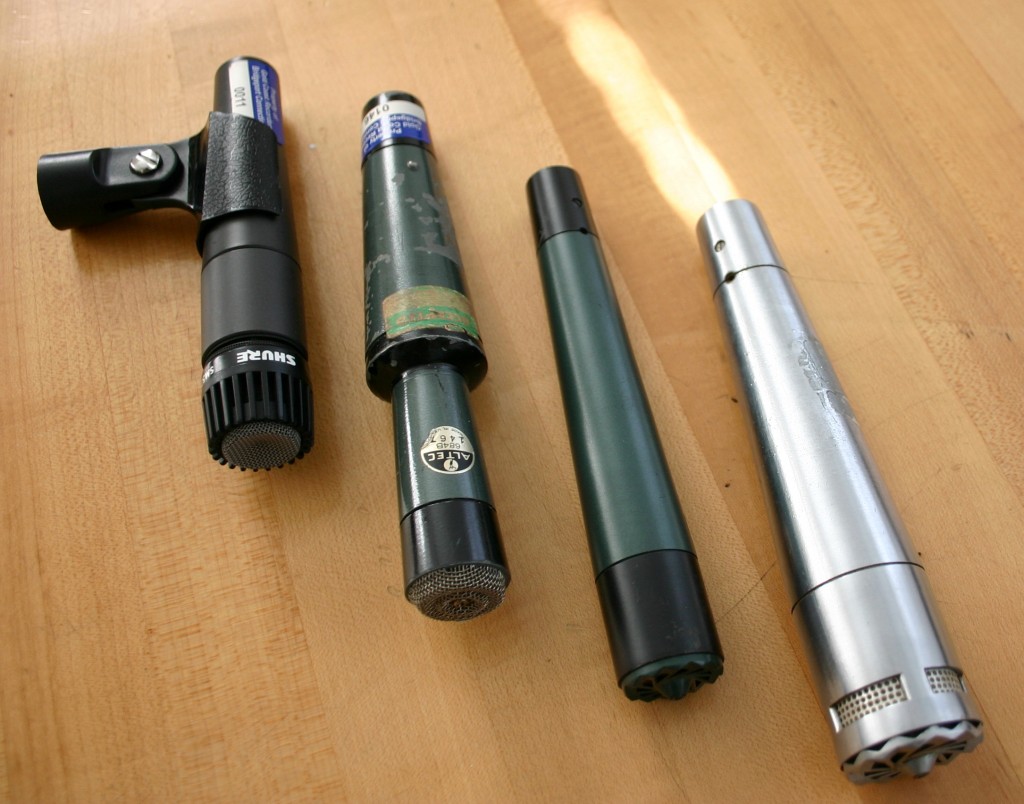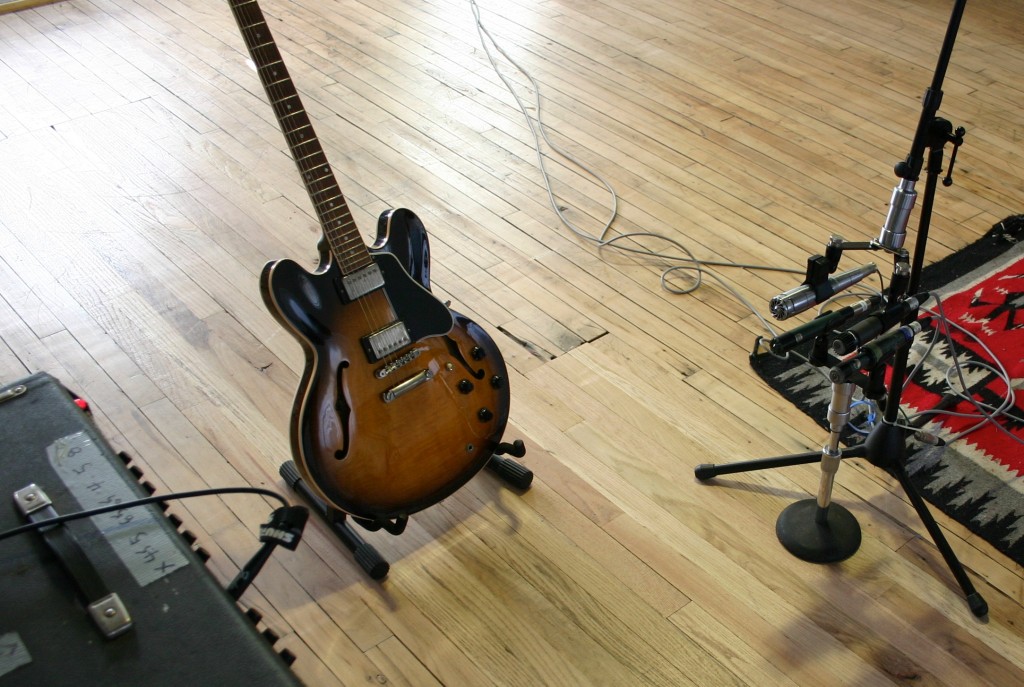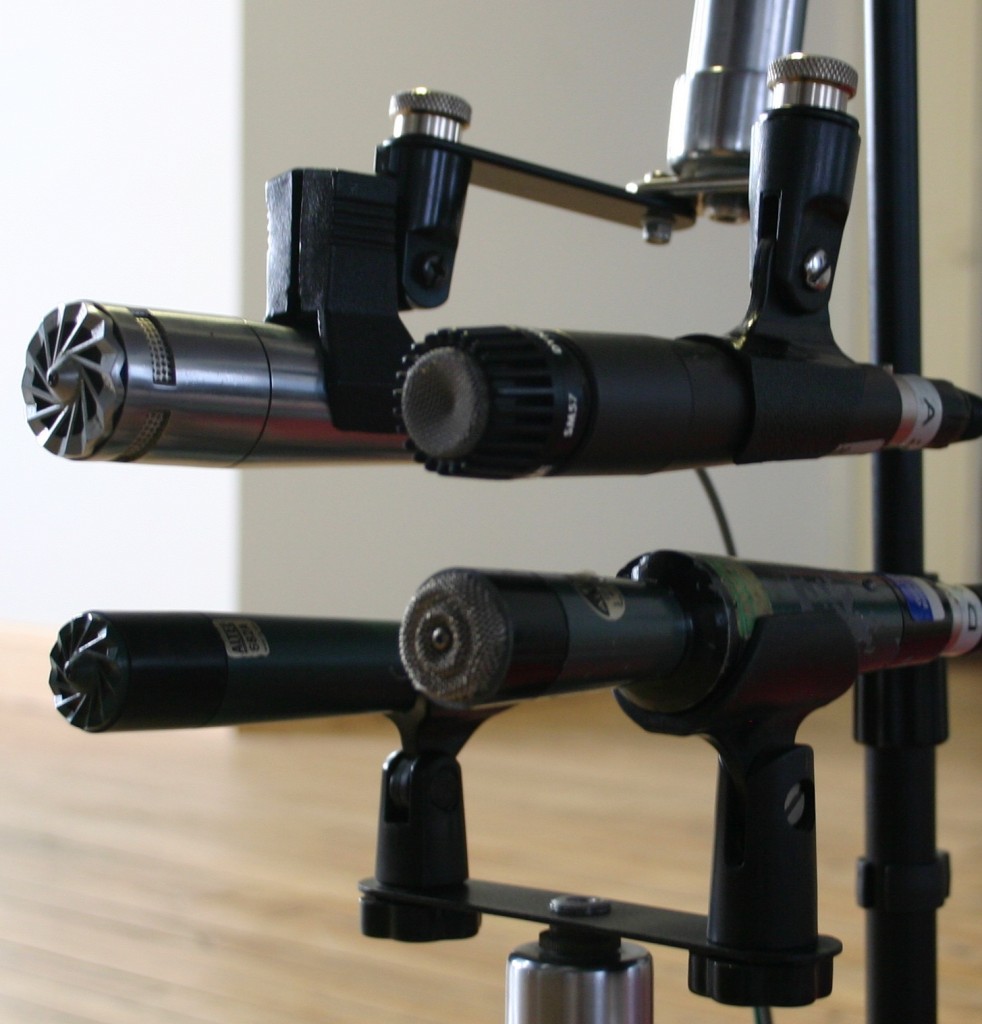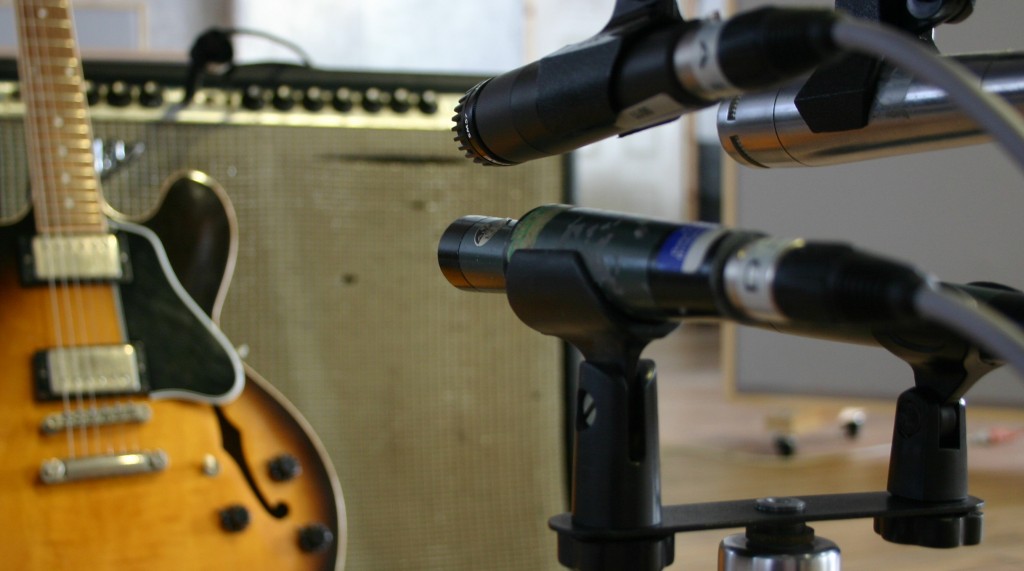 L to R: Shure SM57; Altec 684 Omni; Altec 682 Cardiod; Altec 683 Cardiod
L to R: Shure SM57; Altec 684 Omni; Altec 682 Cardiod; Altec 683 Cardiod
Altec made a great number of different microphone models in the 1950s and 1960s. A certain few of these are still widely used in recording studios today: most notably the 639 ‘Birdcage’ dual-element microphone (see here and here) and their various small diaphragm ‘Laboratory’ condensers (see here, here, and here).
During this period Altec also made a variety of conventional-looking dynamic microphones, some of which have quite good specs on paper. Today we’ll be having a listen to the Altec 682, 683, and 684.
 I’ve prepared three stereo audio tracks which all document an identical solo guitar performance which we tracked in the big room at Gold Coast Recorders. In each of the three tracks, you will hear a new-ish Shure SM57 in the left speaker, and the selected Altec mic in the right speaker. I chose an SM57 as a reference because it is a microphone that most of us are very familiar with and it is often used to mic electric guitar amps. I placed the mics a big further back than I would generally use a dynamic-mic on a guitar amp in order to minimize any differences that might result from the slight variation in mic placement in relation to the amplifier. All signals were taken from the microphone into identical Sytek mic preamps and then directly into Aurora Lynx convertors and into Protools. No processing whatsoever was used other than minimal Digidesign MAXIM on the bounce-buss to ensure strong playback level; it was taking off 0.3db at most.
I’ve prepared three stereo audio tracks which all document an identical solo guitar performance which we tracked in the big room at Gold Coast Recorders. In each of the three tracks, you will hear a new-ish Shure SM57 in the left speaker, and the selected Altec mic in the right speaker. I chose an SM57 as a reference because it is a microphone that most of us are very familiar with and it is often used to mic electric guitar amps. I placed the mics a big further back than I would generally use a dynamic-mic on a guitar amp in order to minimize any differences that might result from the slight variation in mic placement in relation to the amplifier. All signals were taken from the microphone into identical Sytek mic preamps and then directly into Aurora Lynx convertors and into Protools. No processing whatsoever was used other than minimal Digidesign MAXIM on the bounce-buss to ensure strong playback level; it was taking off 0.3db at most.
 Levels were matched initially by running a 1K tone into the guitar amplifier and then fine-tuned on playback to within the tightest possible margin. The 684 Omni required 30% more gain to reach an equal level; the other three mics were within 5% or so of each other in terms of output.
Levels were matched initially by running a 1K tone into the guitar amplifier and then fine-tuned on playback to within the tightest possible margin. The 684 Omni required 30% more gain to reach an equal level; the other three mics were within 5% or so of each other in terms of output.
 Alright now that you’ve seen the setup, here is the audio:
Alright now that you’ve seen the setup, here is the audio:
SM57 vs Altec 682: SM57L_682R
SM57 vs Altec 683: SM57L_683R
SM57 vs Altec 684: SM57L_684R
Have a listen and draw your own conclusions. My quick assessment: the 682 sounds pretty similar to the 57, but IMO a lot prettier, a lot more detailed, and just more presentable in general. The 683 sounds thinner than the 57; bass is notably lacking and there is an aggressive character to the mids. Not sure that I would ever select this mic for anything. The 684 sounds like… an omni mic, so it’s not a valid comparison to a 57, but it does sound pretty decent as an omni. Might make a good under-snare microphone.
All of these forgotten Altecs are available cheaply on eBay from time to time. I’ve never come across one at a flea market or swap meet, though, so I don’t think they are very common. From what I can tell from my limited sample-pool, the ‘A’ designation after the model-number indicates that the mic uses an XLR5 (rather than the current standard XLR3) connector. If you get one of these ‘A’ designated mics, you will need to find an XLR 5 female jack. Wire an adapter to XLR 3 as follows: (XLR5:XLR3) 1:1, 2:3, 4:2. The ‘B’ designated mics seem to have our current-standard XLR3 jacks. Again, I am not 100% about this distinction, so check closely before buying if you don’t wanna be soldering adapters.
8 replies on “Studio test of obscure circa 1965 Altec dynamic microphones”
I enjoyed listening to this comparison. Those vintage mics sound great!
I’m going to keep any eye for them.
I have a question about the music. I really liked the part that was being played.
I was wondering if its from an old song, or something you made up on the go for the purpose of the mic comparison.
thanks for you time. And i love your blog.
-al
hi alex. thanks for the kind words. yea that’s just me improvising in my usual gtr style. drop D fingerpicking. you can hear more of it at: http://hallelujah.bandcamp.com/
check out ‘stray dogs of men.’
c.
I listened to the 683 and it seems the Altec has better highs and all around better sound. I’m interested because I was just going through some of my brother’s stuff and came across a brand new matched pair of 683B mics. I was wondering what the specs were like. My brother mentioned (before he passed away 3+ years ago) that he was sure they were a matched pair. Ever hear of such? Great pickin’ by the way. I have a 5 piece country band. Lead vocals & rhythm guitar.
I was out plundering around in one of our barns where we have a lot of antique electronics. There are several gems in there I would love to rehab, such as a pair of Quad 8 – TFB-200 power amps, an old Altec I think the number is A126 power amp (bring a dolly ;o) . Funny but I ran across our pile of old mic’s like Turners, and some others, and found the Altec 682A 5 pin mic from you review. I was of course Google-ing the mic and ran across your article, pretty cool, was nice to know there was someone else that knew about them.
THX
Michael
I can’t seem to find specs on these mics…..Is the 682A high or low imp? Freq response and flatness?
Thanks for the test and review, I enjoyed the read and the samples.
However, regarding the 682, I believe it is an omni type based on the Altec documentation that I’ve read. Is it possible there were two versions? Either way it sounded great.
Hi,
I was probably wrong, or misled. I doubt that they would use the same # for different patterns.The A/B/C ETC generally would distinguish different jack termination types or generations.
Interesting, in that case, very good performance for an omni-mic by the 682, I thought it sounded great in your clips!